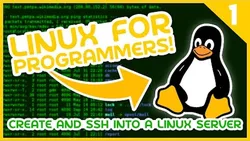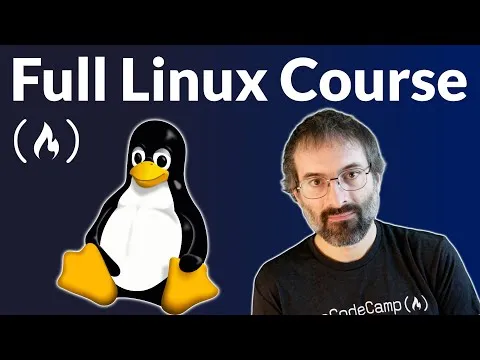
Linux for Programmers 
This course provides an introduction to Linux for programmers. It covers topics such as creating and SSHing into a Linux machine, the Linux filesystem and common commands, users and groups, and file permissions and chmod. It is designed to help programmers become familiar with the Linux environment. ▼
ADVERTISEMENT
Course Feature
![]() Cost:
Cost:
Free
![]() Provider:
Provider:
Youtube
![]() Certificate:
Certificate:
Paid Certification
![]() Language:
Language:
English
![]() Start Date:
Start Date:
On-Demand
Course Overview
❗The content presented here is sourced directly from Youtube platform. For comprehensive course details, including enrollment information, simply click on the 'Go to class' link on our website.
Updated in [February 21st, 2023]
Linux for Programmers #1 - Create and SSH Into a Linux Machine.
Linux for Programmers #2 - FileSystem & Common Linux Commands.
Linux For Programmers #3 - Users and Groups.
Linux For Programmers #4 - File Permissions and chmod.
Linux for Programmers #5 - Processes, htop & top.
Linux for Programmers #6 - Basic Linux Networking Commands.
Linux for Programmers #7 - Public/Private Key Authentication (RSA) & FTP.
Linux for Programmers #8 - Environment Variables On Linux.
Linux For Programmers #9 - Linux Text Editors (Nano, Vim & Emacs).
Linux for Programmers #10 - Grep Command & Regular Expressions.
Linux For Programmers #11 - Shell Scripts.
Linux for Programmers #12 - Cronjobs.
Linux for Programmers #13 - Advanced Commands.
Linux for Programmers #14 - Deploying a Simple Python Web Server.
Linux for Programmers #15 - How to Connect a Domain to a Linode Server.
(Please note that we obtained the following content based on information that users may want to know, such as skills, applicable scenarios, future development, etc., combined with AI tools, and have been manually reviewed)
1. You can learn the basics of Linux, such as creating and SSH into a Linux machine, understanding the file system and common Linux commands, and managing users and groups.
2. You can learn how to manage file permissions and use the chmod command. You can also learn about processes, htop and top.
3. You can learn about Linux networking commands, public/private key authentication (RSA) and FTP. You can also learn about environment variables on Linux.
4. You can learn about Linux text editors, such as Nano, Vim and Emacs. You can also learn about grep command and regular expressions.
5. You can learn about shell scripts, cronjobs, advanced commands, deploying a simple Python web server, and how to connect a domain to a Linode server.
[Applications]
After completing the Linux for Programmers course, participants should be able to apply their knowledge to create and SSH into a Linux machine, understand the Linux filesystem and common commands, manage users and groups, set file permissions, manage processes, use basic Linux networking commands, use public/private key authentication and FTP, understand environment variables, use Linux text editors, use grep command and regular expressions, create shell scripts, set up cronjobs, use advanced commands, deploy a simple Python web server, and connect a domain to a Linode server.
[Career Paths]
1. Linux System Administrator: A Linux System Administrator is responsible for the installation, configuration, and maintenance of Linux systems. They must be knowledgeable in the use of Linux commands and scripting languages, as well as have a good understanding of networking and security. As the demand for cloud-based services increases, the need for Linux System Administrators is expected to grow.
2. Linux Developer: A Linux Developer is responsible for developing applications and software for Linux systems. They must be proficient in programming languages such as C, C++, Java, and Python, as well as have a good understanding of Linux commands and scripting languages. As the demand for cloud-based services increases, the need for Linux Developers is expected to grow.
3. Linux Network Engineer: A Linux Network Engineer is responsible for designing, implementing, and maintaining networks based on Linux systems. They must be knowledgeable in the use of Linux commands and scripting languages, as well as have a good understanding of networking and security. As the demand for cloud-based services increases, the need for Linux Network Engineers is expected to grow.
4. Linux Security Engineer: A Linux Security Engineer is responsible for ensuring the security of Linux systems. They must be knowledgeable in the use of Linux commands and scripting languages, as well as have a good understanding of networking and security. As the demand for cloud-based services increases, the need for Linux Security Engineers is expected to grow.
Course Provider

Provider Youtube's Stats at AZClass
Discussion and Reviews
0.0 (Based on 0 reviews)
Explore Similar Online Courses

Create professional mockups on Moqups

Paint Expressive Human Figures in Watercolor

Python for Informatics: Exploring Information

Social Network Analysis

Introduction to Systematic Review and Meta-Analysis

The Analytics Edge

DCO042 - Python For Informatics

Causal Diagrams: Draw Your Assumptions Before Your Conclusions

Whole genome sequencing of bacterial genomes - tools and applications

Introduction to Linux : Full Course for Beginners

The 50 Most Popular Linux & Terminal Commands - Full Course for Beginners


Start your review of Linux for Programmers